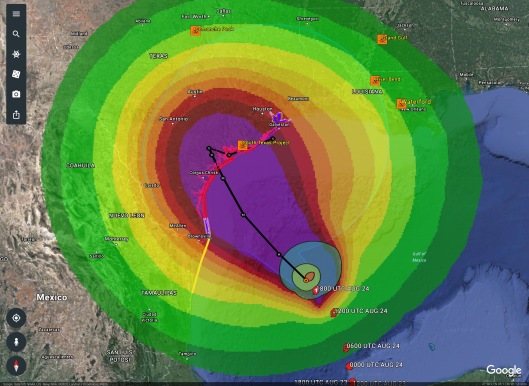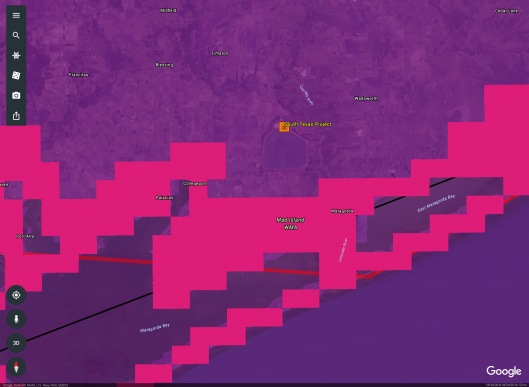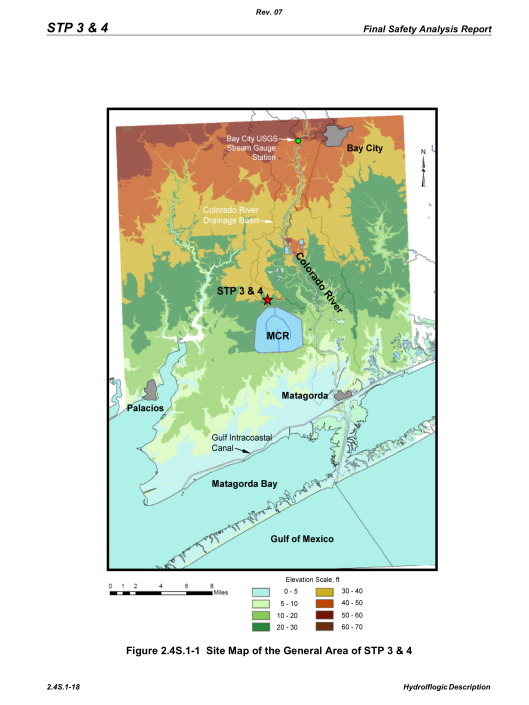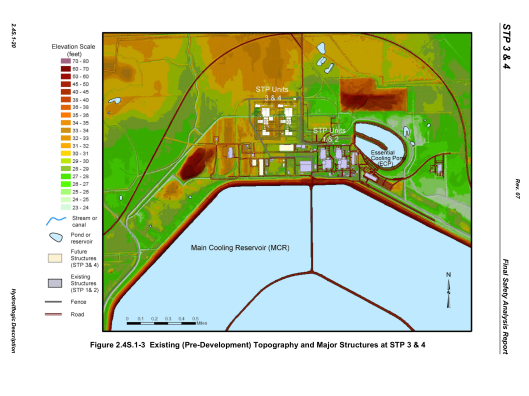NUCLEAR POWER PLANT NEAR EYE
OF HURRICANE HARVEY
HAARP IS IN PLAY
August 25, 2017: MAJOR UPDATE/HURRICANE HARVEY:
Hurricane Harvey Targets South Texas Nuclear Power Station With High Dam Failure Vulnerability
25
Friday
Aug 2017
Posted 
Hurricane Harvey Updates here: http://www.nhc.noaa.gov
Hurricane Harvey’s forecast track targets a two reactor nuclear power
station called the South Texas Project (STP). An internal US NRC memo
leaked to the public (see below) classified it as being High on Dam
Hazard Vulnerability due to the cooling pond, though they probably mean
the Main Cooling Reservoir. There is-was a proposal for two more
reactors at the site (STP 3 and 4). Information on the proposed reactors
includes some relevant information on the site: “The STP 3 & 4 site is located 10.5 miles inland from Matagorda Bay and 16.9 miles inland from the Gulf of Mexico.
It is approximately 75 miles from the Continental Shelf. The shoreline
of Matagorda Peninsula along the Gulf of Mexico changes constantly,
retreating landward or advancing seaward as the result of a combination
of hydrologic and meteorological processes, climatic factors as well as
engineering activities…. The STP 3 & 4 site is located in Matagorda
County, Texas near the west bank of the Colorado River, opposite river
mile 14.6. It is approximately 12 miles south-southwest of Bay City,
Texas, and 8 miles north-northwest of Matagorda, Texas (Figure
2.4S.1-1). The surface elevation of the site ranges from about El. 32 to 34 ft mean sea level (MSL), which is equivalent to National Geodetic Vertical Datum of 1929 (NGVD 29), at the north boundary to between El. 15 ft to 20 ft MSL at the south boundary… A major feature of the site is the
Main Cooling Reservoir (MCR), which is formed by a 12.4-mile-long
earthfill embankment constructed above the natural ground surface. The
MCR has a surface area of 7000 acres with a normal maximum operating
level of El. 49 ft MSL. The MCR is not a safety-related
facility. Makeup water to the MCR is supplied from the Colorado River
and pumped into the MCR intermittently throughout the year via the
Reservoir Makeup Pumping Facility (RMPF). A smaller separate cooling
pond, referred to as the Essential Cooling Pond (ECP), serves as the
ultimate heat sink for STP 1 & 2. The surface area of the ECP is 46
acres. (Reference 2.4S.1-1)
https://www.nrc.gov/docs/ML1204/ML12048A985.pdf.

Failure of the earthen embankment, is not the only hazard, however:
“When faced with a hurricane or other foreseeable severe weather event, nuclear reactors are required to manually shut down as a safety precaution when certain conditions exist. The South Texas nuclear power station in Bay City, Texas and the Waterford nuclear power station near Baton Rouge, LA are required to shut down when hurricane force winds speeds reach 73 and 74 miles per hour, respectively. Nuclear reactor operators will also shut down the reactor in advance of the arrival of hurricane force winds. In some cases, where utilities do not have a sufficient amount of non-nuclear back-up power, this will cause a loss of electrical power before the storm even arrives.
While most nuclear reactors built in potential hurricane zones are designed to structurally withstand high winds and modest flooding, they are vulnerable to other effects of severe storms.
The most significant event is the loss of offsite power, a problem that can lead to a “station blackout.”
During operation, all atomic reactors rely upon alternating current (AC) electricity generated and transmitted from offsite sources to provide the power needed to operate the reactor’s vital safety systems. Without these systems in operation, even when the reactor is shut down, the thermally hot and radioactive fuel inside the reactor would quickly overheat and cause a nuclear meltdown.
According to U.S. Nuclear Regulatory Commission findings documented in NUREG-1150 “Severe Accident Risks: An Assessment for Five U.S. Nuclear Power Plants,” station blackout is the number one contributor of risk to the public, with risk defined as a combination of probability and serious consequences.
When offsite AC power is lost due to electrical grid failure, reactors are designed to automatically switch over to required backup emergency diesel generators. These are locomotive-size, fuel-guzzling generators that provide enough power to operate a narrower but basic set of reactor safety systems. Each reactor unit is required to have at least two emergency diesel generators onsite. Should these backup generators fail due to overheating, mechanical failure or the fouling of the diesel fuel, etc. a smaller subset of vital reactor cooling instrumentation and control systems would rely upon power from large on-site battery banks. The failure of both onsite and offsite AC power supplies result in the condition known as station blackout. According to the NRC safety study, a station blackout leads to battery depletion after approximately 4 hours and sets in motion a time table where “approximately 3 hours beyond battery depletion was allowed for the restoration of AC power before core uncovery would occur.” Uncovering of the reactor core of cooling water would lead to a meltdown of the extremely hot and radioactive nuclear fuel.
However, the history of emergency diesel generators compliance with operability requirements is checkered….”
Read the rest here: https://www.nirs.org/wp-content/uploads/reactorwatch/natureandnukes/nukesandhurricanes092205.pdf
Storm surge prediction for Harvey:


http://www.nhc.noaa.gov
South Texas Nuclear site elevation maps:


https://www.nrc.gov/docs/ML1204/ML12048A985.pdf

More details found here: https://www.peer.org/assets/docs/nrc/12_17_13_NRC_risk_assessment.pdf
Chart found here, compliments of Greenpeace: http://environmentalarchives.com/download/2012-nrc-qualitative-preliminary-assessment-dam-hazard-vulnerabilities-operation-nuclear-power-plants-united-states/
Related: https://miningawareness.wordpress.com/2016/01/03/nuclear-strategic-alliance-for-flex-emergency-response-safer-not-depends-on-emergency-resources-which-may-be-needed-elsewhere-unavailable/
Emphasis our own throughout.
#MrMBB333
https://www.nrc.gov/docs/ML1204/ML12048A985.pdf.

Failure of the earthen embankment, is not the only hazard, however:
“When faced with a hurricane or other foreseeable severe weather event, nuclear reactors are required to manually shut down as a safety precaution when certain conditions exist. The South Texas nuclear power station in Bay City, Texas and the Waterford nuclear power station near Baton Rouge, LA are required to shut down when hurricane force winds speeds reach 73 and 74 miles per hour, respectively. Nuclear reactor operators will also shut down the reactor in advance of the arrival of hurricane force winds. In some cases, where utilities do not have a sufficient amount of non-nuclear back-up power, this will cause a loss of electrical power before the storm even arrives.
While most nuclear reactors built in potential hurricane zones are designed to structurally withstand high winds and modest flooding, they are vulnerable to other effects of severe storms.
The most significant event is the loss of offsite power, a problem that can lead to a “station blackout.”
During operation, all atomic reactors rely upon alternating current (AC) electricity generated and transmitted from offsite sources to provide the power needed to operate the reactor’s vital safety systems. Without these systems in operation, even when the reactor is shut down, the thermally hot and radioactive fuel inside the reactor would quickly overheat and cause a nuclear meltdown.
According to U.S. Nuclear Regulatory Commission findings documented in NUREG-1150 “Severe Accident Risks: An Assessment for Five U.S. Nuclear Power Plants,” station blackout is the number one contributor of risk to the public, with risk defined as a combination of probability and serious consequences.
When offsite AC power is lost due to electrical grid failure, reactors are designed to automatically switch over to required backup emergency diesel generators. These are locomotive-size, fuel-guzzling generators that provide enough power to operate a narrower but basic set of reactor safety systems. Each reactor unit is required to have at least two emergency diesel generators onsite. Should these backup generators fail due to overheating, mechanical failure or the fouling of the diesel fuel, etc. a smaller subset of vital reactor cooling instrumentation and control systems would rely upon power from large on-site battery banks. The failure of both onsite and offsite AC power supplies result in the condition known as station blackout. According to the NRC safety study, a station blackout leads to battery depletion after approximately 4 hours and sets in motion a time table where “approximately 3 hours beyond battery depletion was allowed for the restoration of AC power before core uncovery would occur.” Uncovering of the reactor core of cooling water would lead to a meltdown of the extremely hot and radioactive nuclear fuel.
However, the history of emergency diesel generators compliance with operability requirements is checkered….”
Read the rest here: https://www.nirs.org/wp-content/uploads/reactorwatch/natureandnukes/nukesandhurricanes092205.pdf
Storm surge prediction for Harvey:


http://www.nhc.noaa.gov
South Texas Nuclear site elevation maps:


https://www.nrc.gov/docs/ML1204/ML12048A985.pdf

More details found here: https://www.peer.org/assets/docs/nrc/12_17_13_NRC_risk_assessment.pdf
Chart found here, compliments of Greenpeace: http://environmentalarchives.com/download/2012-nrc-qualitative-preliminary-assessment-dam-hazard-vulnerabilities-operation-nuclear-power-plants-united-states/
Related: https://miningawareness.wordpress.com/2016/01/03/nuclear-strategic-alliance-for-flex-emergency-response-safer-not-depends-on-emergency-resources-which-may-be-needed-elsewhere-unavailable/
Emphasis our own throughout.
#MrMBB333

No comments:
Post a Comment